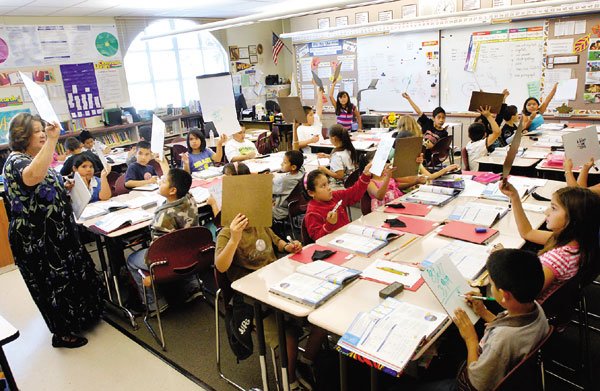Class-size reduction is a program beloved by most teachers,
parents and school administrators, but a predicted budget shortfall
is forcing school trustees to examine whether the program is worth
the cost.
Class-size reduction is a program beloved by most teachers, parents and school administrators, but a predicted budget shortfall is forcing school trustees to examine whether the program is worth the cost.
Although the Gilroy Unified School District receives state funding to limit kindergarten through third grade classrooms to no more than 20 students, GUSD will still need to pull nearly $980,000 from its general fund to maintain the program this school year.
“I think we would all support having small classrooms in concept,” trustee Francisco Dominguez said. “Economically, is it the most affordable thing to do at this time given the economic crisis that we’re in? There hasn’t been any solid evidence that says this is definitely a strategy that should be used to improve academic performance.”
Trustees will take up the sensitive issue in the coming months as they look for ways to shore up an anticipated budget gap for the 2010-11 school year. The amount of the shortfall is still unknown.
“I am a firm believer in class-size reduction, but we are faced with certain economic realities,” trustee Rhoda Bress said. “As the budget continues to be cut, we may have to revisit the issue. We’ve seen the benefits of class-size reduction. Objectively, we’ve definitely seen an improvement in our test results in our elementary grades. More subjectively, I think that class-size reduction provides more opportunities to engage students and for students to be more active and less passive.”
One success story is Eliot Elementary School, which began an aggressive class-size reduction effort two years ago, hiring new teachers to reduce its student-to-teacher ratio to roughly 16 to 1 in kindergarten through third grade classes. Lower scoring students are pulled from their classrooms and meet in ratios as low as 10 to 1, receiving instruction targeted at bringing them up to speed.
“By lowering the ratios, you’re increasing the amount of time you have for each individual student,” said James Dent, Eliot principal and a former fourth grade teacher. “Teachers are able to teach to a narrower range of abilities than when they had to reach all the different levels in their group.”
Meanwhile, higher performing students are grouped in larger classrooms, he said.
“Our highest math classes have 35 students in them,” Dent said. “Those are the students who are very adept. Those kids tend to do well in high ratios or low ratios. It has worked out very well. We have seen improvement.”
Test scores at Eliot have climbed dramatically in the last two years. The school’s scores on a state test known as the Academic Performance Index rose from 674 in 2007 to 759 in 2008. This 85-point jump was the largest in Santa Clara County and far outstripped the goal set for the school by the state.
“This year it looks like we’ll have a nice gain again,” Dent said.
Despite Eliot’s success, the effects of smaller class sizes on student achievement have been the subject of debate.
“In and of itself, if you just put fewer kids in a classroom, you have to go under 15 (students) to get some data to show that student achievement changes,” said Linda Aceves, chief academic officer for the Santa Clara County Office of Education.
But according to a 2002 study by the Public Policy Institute of California, five of the state’s largest school districts reported test score gains since the class-size reduction program began. Third-grade test scores increased 14 percent in math and 9 percent in reading in schools with mostly low-income students.
Besides improved test scores, parents, teachers and administrators see benefits to having fewer students in a classroom.
“As a teacher, you can create more relationships, more relevance, and more rigor in your classroom, and then student achievement will go up,” Aceves said. “Is it easier to do that with fewer kids? Yes, absolutely. But if you do the same thing that you’ve always done but with fewer kids, then no. When all is said and done, it is the instructional practice that makes a difference. It’s the teaching and the learning opportunities that happen.”
Dawn Guillen, president of the Luigi Aprea School Parent Club, said club members will fight any effort to raise the number of kids per class. Her daughter, Sophie, is a second-grader at Luigi Aprea.
“Sophie has 20 or 21 kids in her class. It’s manageable,” Guillen said. “The teacher can give everybody individual attention if it’s necessary. She can speak to the kids every day. Without that kind of a bond, what is it? It’s a daycare.”
The class-size reduction program began under Gov. Pete Wilson in 1996, when California had some of the largest classroom populations in the country and some of the most diverse. The state was awash in money, and Wilson threw $1 billion at the program.
“They graduated it up through some of the early primary levels and hit a roadblock of not having enough money,” said Terry Christensen, a political science professor at San Jose State University.
Today, the state’s contribution to the program has grown to $1.8 billion. Nearly all public school districts statewide participate in class-size reduction, though the program is voluntary. The state provides strong financial incentives to schools to participate. Schools receive $1,071 per child in addition to their usual per-pupil funding.
Although the Gilroy Unified School District receives $3.6 million from the state, it contributes an additional $978,000 from its general fund to support class-size reduction.
“Increases have been minimal in state funding per student,” Superintendent Deborah Flores said. “Our costs continue to go up, and the class-size reduction funding has not kept pace with that.”
Additionally, the state capped the number of classrooms eligible for class-size reduction monies this year at last year’s number of classrooms. Gilroy won’t receive state funds for the classrooms it added due to increased enrollment.
However, Gilroy expects to save some of the money it usually loses in penalties each year. In February, the state decreased some of its penalties for schools exceeding the 20-to-1 ratio in classrooms. Now classes with an average student population between 20.5 and 21.5 lose only 5 percent of their per-pupil funding compared to the previous 30 percent.
Las Animas and Luigi Aprea have slightly more than 20 students in most classrooms this year out of simple necessity.
“At Luigi Aprea they are out of space,” Flores said. “They have no classrooms left.”
Despite all of these challenges, the program has been a high priority for the board and for staff, Flores said.
“At some point, and this might be the year, we may to have look at reducing class-size reduction,” she said.
Months of budget discussions lie ahead. But if Gilroy decides to reduce or eliminate class-size reduction, the district could start by modifying only the third grade. The district can also reinstate the program later.
With many options to consider, trustee Tom Bundros is unsure of the cost savings and said much more research is needed.
“It’s not clear to me right now that there are savings there. The savings would be being able to put more students in a classroom and not requiring as many classrooms and not requiring as many teachers for that population,” he said. “Right now, the state is funding class-size reduction to a certain level. If we eliminate class-size reduction, we no longer get that money from the state. The net result might be that we’re in worse shape.”
Statewide Facts on Class Size
-Ninety-nine percent of California’s public school districts participated in K-3 class-size reduction in 2006-07.
-California ranks 49th nationally in teachers-per-pupil, with 47.6 teachers for every 1,000 students.
-California has the largest student population in the nation and employs more teachers than any other state in the nation.
Source: California Teachers Association, March 2008














